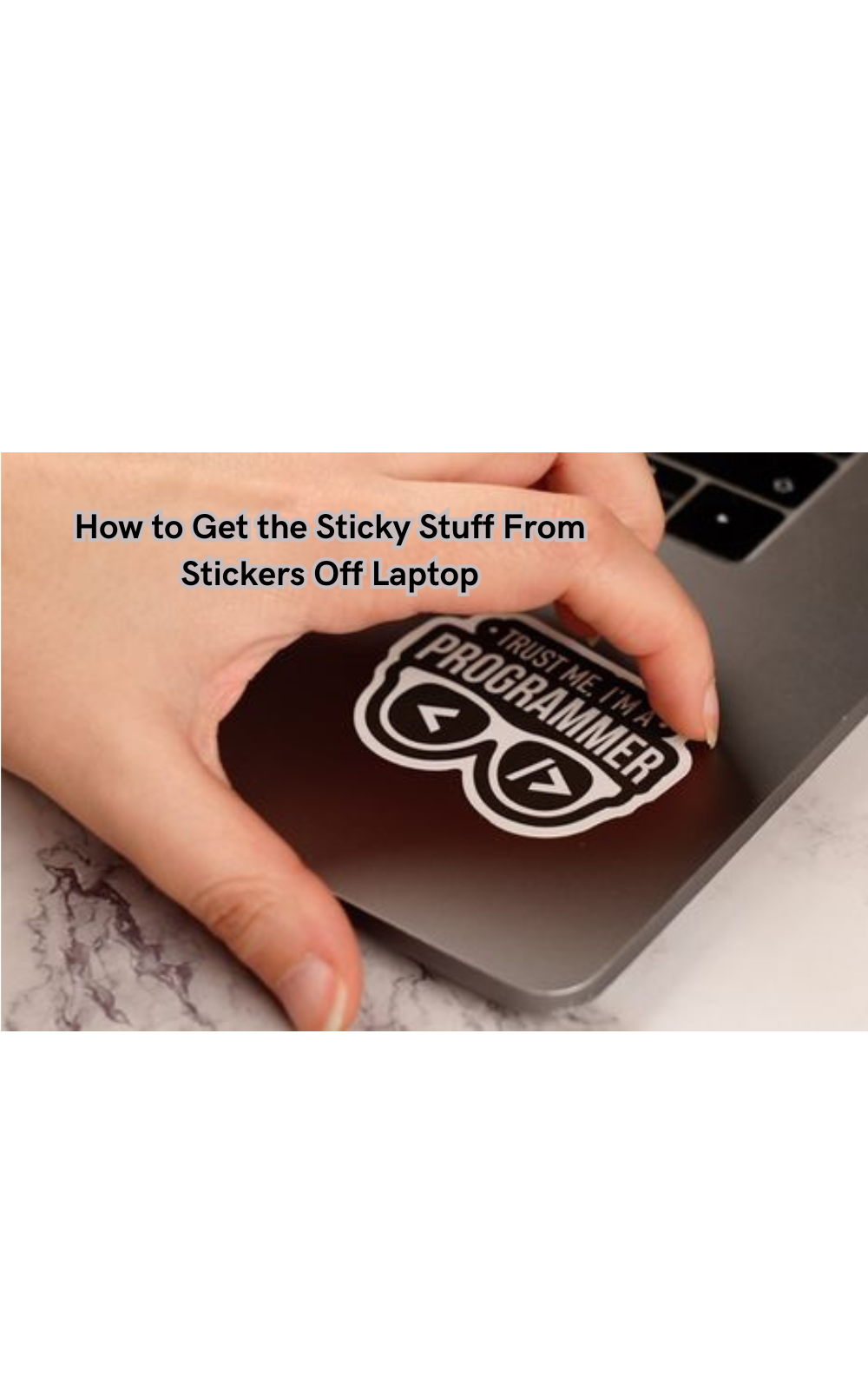How to Get the Sticky Stuff From Stickers Off Laptop
Let's explore some practical techniques to tackle this common nuisance and restore your laptop's sleek look.

Removing stubborn adhesive residue from stickers on a laptop can be a delicate yet achievable task with the right approach. The remnants of stickers, often unsightly and challenging to remove, require gentle yet effective methods to restore the laptop's pristine appearance.
Various household items like rubbing alcohol, vinegar, or even cooking oil can be enlisted to break down the stickiness without damaging the laptop's surface. Patience and a systematic approach are key in ensuring successful sticker residue removal, safeguarding the laptop's finish while restoring it to its original state.
Let's explore some practical techniques to tackle this common nuisance and restore your laptop's sleek look.
Importance of Removing Stickers from Laptops
Stickers often serve as a means of personalization or expression, especially for students or artists. However, their presence on laptops can compromise the device's overall appearance and functionality.
Here are some reasons why removing stickers from laptops is crucial:
- Resale value: If you plan to upgrade or sell your laptop, removing stickers can increase its value.
- Protects laptop's surface: The adhesive residue left behind by stickers can attract dust and debris, potentially damaging the laptop's surface over time.
- Better aesthetic appeal: A clean, sticker-free laptop has a more professional and tidy appearance, making it ideal for work or school.
- Eliminates potential hazards: Stickers covering essential ports or buttons can impede the laptop's functionality and cause overheating issues.
How to Get the Sticky Stuff From Stickers Off Laptop
Now that we understand the importance of removing stickers from laptops, let's look at some effective ways to get rid of the sticky residue.
Gather the Materials
Before beginning the sticker removal process, gather all necessary materials. Some essential items you may need are:
- Rubbing isopropyl alcohol or vinegar
- Cotton pads or swabs
- Microfiber cloth or soft sponge
- Cooking oil (optional)
- Plastic scraper (optional)
Ensure the materials are safe to use on your laptop's surface by first testing them on a small, inconspicuous area. This way, you can avoid any potential damage to your laptop.
Method 1: Using Rubbing Alcohol or Vinegar
Rubbing alcohol and vinegar both contain properties that break down the adhesive and make it easier to remove. Here's a step-by-step guide on using these items to get rid of sticker residue:
- Dampen a cotton pad or swab with rubbing alcohol or vinegar.
- Gently rub the dampened pad over the sticker residue in a circular motion, allowing the solution to soak in for a few minutes.
- Once the adhesive has started loosening, use a microfiber cloth or soft sponge to wipe away the residue.
- If any stubborn spots remain, repeat steps 1-3 until all residue is removed.
- Finally, clean the laptop's surface with a damp cloth and allow it to dry before use.
Method 2: Using Cooking Oil
Cooking oil, like olive or coconut oil, can also remove sticker residue. Here's how to do it:
- Apply a few drops of cooking oil over the sticker residue and let it sit for a few minutes.
- Using a plastic scraper or your fingernail, gently scrape off the softened adhesive.
- Wipe away any remaining residue with a soft cloth or sponge.
- Clean the surface with a damp cloth and allow it to dry before use.
Note: Be cautious when using cooking oil on laptops with a touch screen, as it may leave behind an oily film. Olive oil is generally a safer option than other types of cooking oil.
Tips for Removing Sticker Residue
Now that you know how to get the sticky stuff from stickers off your laptop, here are some tips to keep in mind for a successful removal process:
- For stubborn residue, try heating it up with a hairdryer before using any of the methods mentioned above. The heat will soften the adhesive, making removal easier.
- Avoid using harsh chemicals or abrasive products like nail polish remover, as they can damage the laptop's surface.
- If you're unsure about removing stickers from your laptop yourself, seek professional help to avoid potential damage.
When removing sticky residue from stickers on your laptop, it's essential to be patient and gentle. Rushing or using abrasive methods can cause more harm than good. With the right approach and materials, you can successfully remove sticker residue and restore your laptop's pristine appearance.
Additional Methods for Sticker Removal
If the sticker residue is still proving difficult to remove, here are some alternative methods you can try:
- Using adhesive removers: Products specifically designed to remove adhesive residue, such as Goo Gone or WD-40, can be effective in dissolving sticky substances.
- Using a pencil eraser: A pencil eraser can work wonders in removing small amounts of residue from stickers. Simply rub the eraser over the residue until it lifts off.
- Using a mixture of baking soda and coconut oil: Make a paste by mixing equal parts of baking soda and coconut oil. Apply the paste to the sticker residue and let it sit for a few minutes before wiping it away with a soft cloth.
- Using rubbing alcohol and baking soda: Mix equal parts of rubbing alcohol and baking soda to form a paste. Apply the paste to the sticker residue and let it sit for a few minutes before wiping it away with a damp cloth.
Prevention Tips for Future Sticker Removal
To avoid having to remove stubborn adhesive residue in the future, here are some preventive measures you can take:
- Use removable stickers: Consider using removable stickers instead of permanent ones.
- Peel off carefully: When removing stickers, peel them off slowly and gently to minimize residue.
- Clean regularly: Wiping your laptop's surface with a soft cloth or sponge regularly can prevent sticker residue from building up.
- Avoid placing stickers in critical areas: If you must use stickers on your laptop, avoid placing them over essential ports or buttons to prevent potential functionality issues.
By following these prevention tips, you can keep your laptop looking clean and sticker-free for longer periods.
FAQs
What is the best way to remove stickers and their sticky residue from a laptop?
To effectively remove stickers and their sticky residue from a laptop, gently peel off the sticker as much as possible. Then, use a clean cloth moistened with a mixture of warm water and mild soap to gently rub off the remaining residue. If the residue persists, products designed for removing adhesive can be applied sparingly.
Can baking soda paste be used to remove sticky residue from laptops?
Yes, baking soda paste can be used to remove sticky residue. Mix baking soda with a small amount of water to create a paste, then apply it gently to the residue using a lint-free cloth. Rub the area in a circular motion until the residue lifts off. Wipe the area clean with a damp paper towel afterward.
What should you avoid using when trying to remove sticky residue from a laptop?
When trying to remove sticky residue from a laptop, avoid using abrasive materials like Scotch Brite pads, which can scratch the surface. Instead, opt for softer materials such as lint-free cloths or clean cloths that won't damage the laptop's finish.
How can paper towels be used in the process of removing sticky residue?
Paper towels can be useful in the process of removing sticky residue by helping to blot up any excess liquids used during the cleaning process. After applying a cleaning solution and rubbing the residue with a lint-free cloth, use paper towels to gently dab the area dry. This helps prevent moisture from seeping into the laptop components.
Conclusion
In conclusion, dealing with sticky residue from stickers on a laptop demands a blend of patience, gentle techniques, and the right tools. By approaching the task methodically and using household items like rubbing alcohol, vinegar, or oil, one can effectively dissolve the adhesive without causing harm to the laptop's surface.
Consistent application of these methods, coupled with careful scraping or rubbing, can gradually lift the sticky remnants, restoring the laptop to its original sheen. Remember, a steady hand and a gentle touch are vital in this process to ensure the laptop remains unscathed while bidding farewell to the stubborn sticker remnants.
